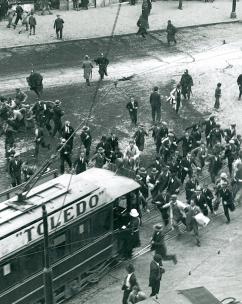In the 1930s, civil war wracked Spain. Under the banner of the Republic, socialists and anarchists and Communists threw in their lot together; the Nationalists – granted force by the military and the Catholic Church – responded to the fears of the middle class.
 Josef Stalin supported the Republic with arms – always for a price – and controlled the Spanish Communist Party through his agents. In 1937 he reached for even greater power over the Republic, and Caballero, their chosen leader, resisted him; that was the end of Caballero. In due time the Soviets arranged a coup, overthrowing Caballero as head of the Republic and replacing him with a puppet of their own choosing. Thus enabled, the Communists – themselves under the terror of Stalin’s brutal enforcers – took over the Republic of Spain.
Josef Stalin supported the Republic with arms – always for a price – and controlled the Spanish Communist Party through his agents. In 1937 he reached for even greater power over the Republic, and Caballero, their chosen leader, resisted him; that was the end of Caballero. In due time the Soviets arranged a coup, overthrowing Caballero as head of the Republic and replacing him with a puppet of their own choosing. Thus enabled, the Communists – themselves under the terror of Stalin’s brutal enforcers – took over the Republic of Spain.
And then – following the script Stalin had already written for Russia – the Communists began a purge, the slaughter of their erstwhile political allies. The Republic, while still in a civil war with the Nationalists, entered into a civil war with each other. The Communists tortured and murdered their fellow Leftists by the thousands. Many foreigners were marked for murder; some managed to escape.
George Orwell was among them. After fleeing the bloodbath, he attempted to expose it in print. One editor turned him down on the grounds that it would damage Western support for the Republic.
That editor was wrong. When Orwell finally got his story printed, it affected the Republic very little. The 1930s intellectual elite were more entranced with Communism than the truth, more concerned about Stalin than about the cruelties engulfing life after life in Spain. They assured the victory of the brilliant Communist propaganda.
In a 1946 essay called “Why I write”, Orwell stated, “The Spanish war and other events in 1936-37 turned the scale and thereafter I knew where I stood. Every line of serious work that I have written since 1936 has been written, directly or indirectly, against totalitarianism and for democratic socialism, as I understand it.”
Three years later, he published 1984, modeling his hero Emanuel Goldstein after Andres Nin, a Spanish political leader murdered by the Stalinists in the Republic’s fratricide.
Dystopias are the nightmares of their authors, which are in some measure the nightmares of their societies. They write what they see and what they fear. George Orwell, emerging from the horrors of the 1930s, wrote about totalitarian states, their cruelty and their conquest of truth.
In Captives, Jill Williamson builds a dystopia of our own phantoms – polluted earth, Big Brother, complete social collapse, the final scrapping of all traditional morality. Today Captives begins its CSFF blog tour; I’ll be along with my review later. You can begin your exploration of this twenty-first century dystopia here:
Captives on Amazon;
Jill Williamson’s website;
and, of course, the blog tour:
Julie Bihn
Thomas Fletcher Booher
Keanan Brand
Beckie Burnham
Morgan L. Busse
Jeff Chapman
Pauline Creeden
Emma or Audrey Engel
Victor Gentile
Timothy Hicks
Jason Joyner
Carol Keen
Meagan @ Blooming with Books
Rebecca LuElla Miller
Joan Nienhuis
Asha Marie Pena
Nathan Reimer
Chawna Schroeder
Jojo Sutis
Jessica Thomas
Steve Trower
Phyllis Wheeler
Rachel Wyant

What an interesting post, Shannon–something I wouldn’t have thought of in a million years. Great job researching this and laying out the history so clearly.
I wish I had read 1984 recently so I could compare it with today’s dystopians.
That could have been interesting, too.
I’m looking forward to what else you have to say in conjunction with Captives.
Becky
Thanks, Becky. I knew nothing about the Spanish civil war – still less about its influence on George Orwell and 1984 – until I read Modern Times. It so intrigued me that it lodged in my memory; when I read these Christian dystopias – Storm and Captives – I thought of it again.